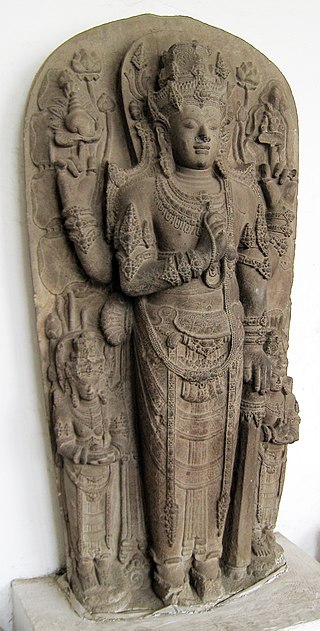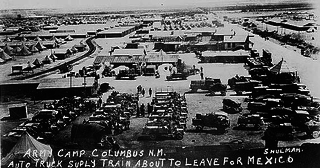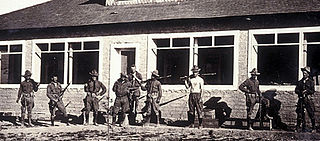
The 13th century was the century which lasted from January 1, 1201 through December 31, 1300 (MCCC) in accordance with the Julian calendar.
The Benin Expedition of 1897 was a punitive expedition by a British force of 1,200 men under Sir Harry Rawson. It came in response to the ambush and slaughter of a 250 strong party led by British Acting Consul General James Phillips of the Niger Coast Protectorate. Rawson's troops captured Benin City, bringing to an end slavery and human sacrifice in Benin, and indeed the Kingdom of Benin itself, which was eventually absorbed into colonial Nigeria. The expedition freed slaves held by the Oba.

Singhasari, also known as Tumapel, was a Javanese Hindu-Buddhist kingdom located in east Java between 1222 and 1292. The kingdom succeeded the Kingdom of Kediri as the dominant kingdom in eastern Java. The kingdom's name is cognate to the Singosari district of Malang Regency, located several kilometres north of Malang City.
The Mexican Border Service Medal was a U.S. service medal established by an Act of Congress on July 9, 1918. It was awarded for service on the border between May 9, 1916 and March 24, 1917. Additionally, recipients included those who performed duty with the Mexican Border Patrol between January 1, 1916 and April 6, 1917.

The Pancho Villa Expedition—now known officially in the United States as the Mexican Expedition, but originally referred to as the "Punitive Expedition, U.S. Army"—was a military operation conducted by the United States Army against the paramilitary forces of Mexican revolutionary Francisco "Pancho" Villa from March 14, 1916, to February 7, 1917, during the Mexican Revolution of 1910–1920.

The British Expedition to Abyssinia was a rescue mission and punitive expedition carried out in 1868 by the armed forces of the British Empire against the Ethiopian Empire. Emperor Tewodros II of Ethiopia, then often referred to by the anglicized name Theodore, imprisoned several missionaries and two representatives of the British government in an attempt to force the British government to comply with his requests for military assistance. The punitive expedition launched by the British in response required the transportation of a sizeable military force hundreds of kilometres across mountainous terrain lacking any road system. The formidable obstacles to the action were overcome by the commander of the expedition, General Robert Napier, who captured the Ethiopian capital, and rescued all the hostages.

Raden Wijaya or Raden Vijaya was a Javanese emperor, and the founder and first monarch of the Majapahit Empire. The history of his founding of Majapahit was written in several records, including Pararaton and Negarakertagama. His rule was marked by the victory against the army and the Mongol navy of Kublai Khan's Yuan dynasty.

The Apache Scouts were part of the United States Army Indian Scouts. Most of their service was during the Apache Wars, between 1849 and 1886, though the last scout retired in 1947. The Apache scouts were the eyes and ears of the United States military and sometimes the cultural translators for the various Apache bands and the Americans. Apache scouts also served in the Navajo War, the Yavapai War, the Mexican Border War and they saw stateside duty during World War II. There has been a great deal written about Apache scouts, both as part of United States Army reports from the field and more colorful accounts written after the events by non-Apaches in newspapers and books. Men such as Al Sieber and Tom Horn were sometimes the commanding officers of small groups of Apache Scouts. As was the custom in the United States military, scouts were generally enlisted with Anglo nicknames or single names. Many Apache Scouts received citations for bravery.

Sri Maharajadiraja Sri Kertanegara Wikrama Dharmatunggadewa, Kritanagara, or Sivabuddha, was the last and most important ruler of the Singhasari kingdom of Java, reigning from 1268 to 1292. Under his rule Javanese trade and power developed considerably, reaching the far corners of the Indonesian archipelago.

The Yuan dynasty under Kublai Khan attempted in 1293 to invade Java, an island in modern Indonesia, with 20,000 to 30,000 soldiers. This was intended as a punitive expedition against Kertanegara of Singhasari, who had refused to pay tribute to the Yuan and maimed one of their emissaries. However, in the intervening years between Kertanegara's refusal and the expedition's arrival on Java, Kertanegara had been killed and Singhasari had been usurped by Kediri. Thus, the Yuan expeditionary force was directed to obtain the submission of its successor state, Kediri, instead. After a fierce campaign, Kediri surrendered, but the Yuan forces were betrayed by their erstwhile ally, Majapahit, under Raden Wijaya. In the end, the invasion ended with Yuan failure and strategic victory for the new state, Majapahit.

The Village of Columbus and Camp Furlong is a National Historic Landmark District commemorating the 1916 raid by Pancho Villa on the town of Columbus, New Mexico, and the American military response to that raid, the "Punitive Expedition" led by General John J. Pershing. The raid and its response, set during World War I, the Mexican Revolution, and an accompanying low-level Border War, played a significant role in diplomacy and military preparedness for eventual American entry in the World War. The district encompasses buildings that survived the raid, and military facilities used in the American response. The landmark designation was made in 1975.

The Battle of Columbus, March 9, 1916, began as a raid conducted by remnants of Pancho Villa's Division of the North on the small United States border town of Columbus, New Mexico, located 3 miles (4.8 km) north of the border with Mexico. The raid escalated into a full-scale battle between Villistas and the United States Army.
Mexico was a neutral country in World War I, which lasted from 1914 to 1918. The war broke out in Europe in August 1914 as the Mexican Revolution was in the midst of full-scale civil war between factions that had helped oust General Victoriano Huerta from the presidency earlier that year. The Constitutionalist Army of Venustiano Carranza under the generalship of Alvaro Obregón defeated the army of Pancho Villa in the Battle of Celaya in April 1915.

The Mexican Border War, or the Border Campaign, was a series of military engagements which took place in the Mexican–American border region of North America during the Mexican Revolution. The period of the war encompassed World War I, and the German Empire attempted to have Mexico attack the United States, as well as engaging in hostilities against American forces there itself.
Jayakatwang was the king of short-lived second Kingdom of Kediri of Java, after his overthrow of Kertanegara, the last king of Singhasari. He was eventually defeated by Raden Wijaya, Kertanegara's son-in-law using the troops of the Mongol Yuan dynasty that were invading Java. Raden Wijaya would later turn against the Mongols and found Majapahit, a great empire centered around Java.

The Battle of Parral, on April 12, 1916, was the first battle between soldiers of Venustiano Carranza, known as Carrancistas, and the United States military during the Mexican Expedition. When a small force of American cavalry was leaving the city of Parral, in the Mexican state of Chihuahua, a superior force of Carrancista soldiers attacked which resulted in a bloody running engagement. Using a strategy of organized withdrawal, the Americans were able to repulse the Mexican attacks and safely escape to the fortified village of Santa Cruz de Villegas.

The Battle of Guerrero, or the Battle of San Geronimo, in March 1916, was the first military engagement between the rebels of Pancho Villa and the United States during the Mexican Expedition. After a long ride, elements of the American 7th Cavalry Regiment encountered a large force of Villistas at the town of Guerrero in the Mexican state of Chihuahua. In what has been called the "last true cavalry charge," the Americans assaulted the town and routed the defenders, inflicting over seventy-five casualties on the Mexicans with the loss of only five men wounded.

The raid on Glenn Springs occurred on the night of May 5–6, 1916, when Mexican Villistas and Carrancistas attacked the towns of Boquillas and Glenn Springs, Texas. In Glenn Springs, the raiders burned several buildings and fought a three-hour battle with a small force of American soldiers who were stationed there. At the same time, a second party of rebels robbed a general store and a silver mine in Boquillas. Four Americans were killed and the rebels took two hostages to Coahuila. In response to the attack, the United States Army launched a short punitive expedition into Mexico, fought with the rebels, and rescued the captives.
The Raid onSan Ygnacio refers to a battle fought on June 15, 1916 between the United States Army and Mexican raiders near the border town of San Ygnacio, Texas. Three different Mexican factions were known to have launched raids into Texas at the time but most of the evidence suggests that either Seditionists or Carrancistas were responsible for the incursion. Four American soldiers were killed during the battle, along with at least six of the raiders, and the resulting American punitive expedition further strained the already hostile relationship between the Mexican and United States governments.
General Ologbosere, also known as Chief Irabor, resisted the conquest of Benin Empire before he was captured and killed.
















